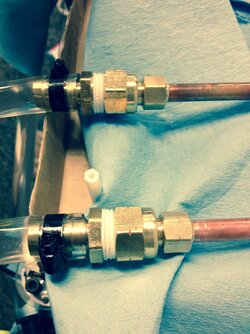- Joined
- Jul 14, 2004
- Location
- westminster, CO
I'm looking for some type of fitting to go from 3/8" OD Copper to 1/2" ID primochill tubing as the title says. Currently, I have a 3/8" OD compression coupling with female threads and then screw in a male thread to 1/2" barb. It is currently very slowly leaking from both the compression fitting and the thread connection after I tightened them with 2 crescent wrenches. I think I can fix the threaded part with using a bit more of the white plumbers tape but I'm not sure how to make a better connection with these compression fittings.
Can anyone think of a better approach? I can't find a 1/4" sweat to 1/2" barb (PEX) connector anywhere so my next idea was to get a 1/4" to 1/2" copper to copper adapter fitting and then run a small piece of 1/2" copper to a 1/2" sweat to 1/2" barb. That seems like a pain in the rear end but the only way I'm going to get a higher rated PSI connection than compression.
Can anyone think of a better approach? I can't find a 1/4" sweat to 1/2" barb (PEX) connector anywhere so my next idea was to get a 1/4" to 1/2" copper to copper adapter fitting and then run a small piece of 1/2" copper to a 1/2" sweat to 1/2" barb. That seems like a pain in the rear end but the only way I'm going to get a higher rated PSI connection than compression.
